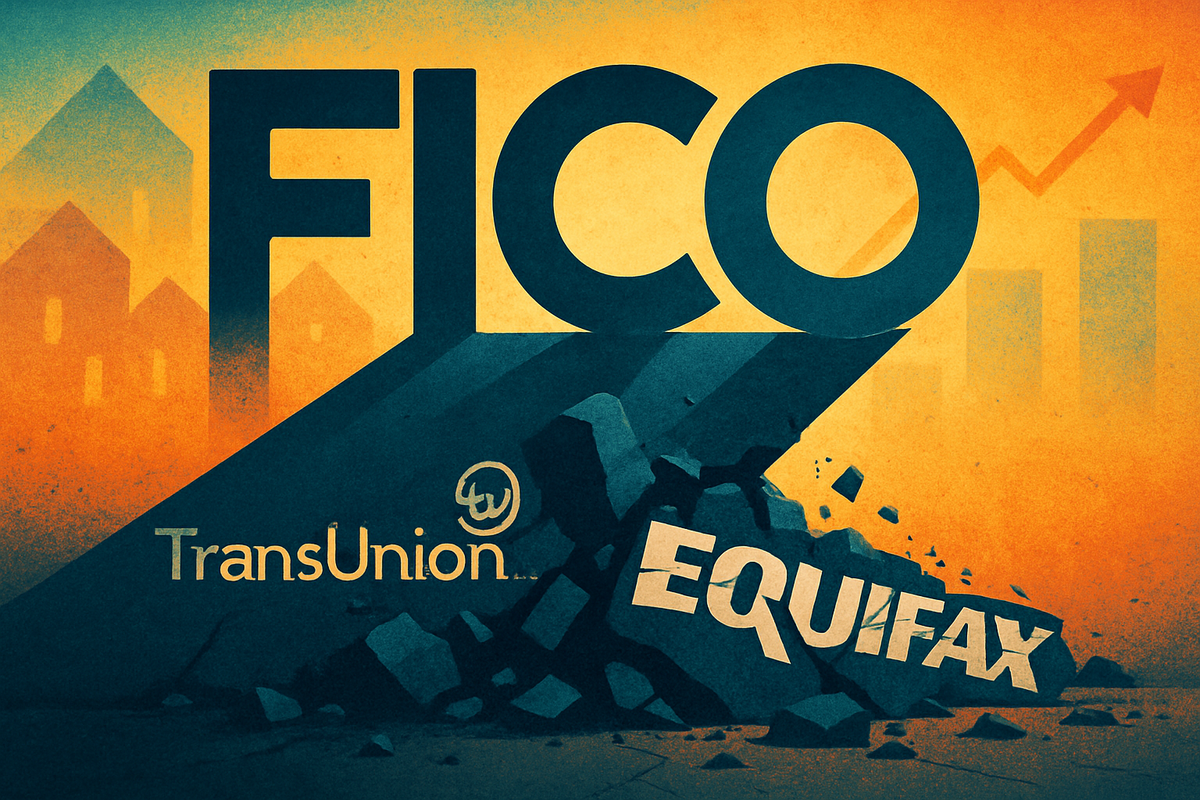
The financial markets are abuzz today, October 2, 2025, following a groundbreaking announcement from Fair Isaac Corporation (NYSE: FICO), the developer of the widely used FICO Score. The company has launched its "FICO Mortgage Direct License Program," a strategic initiative poised to fundamentally alter how FICO Scores are accessed and priced within the mortgage industry. This move, effective October 1, 2025, allows mortgage lenders and tri-merge resellers to obtain FICO Scores directly from FICO, effectively bypassing the traditional intermediary role of the major credit reporting agencies (CRAs) such as TransUnion (NYSE: TRU) and Equifax (NYSE: EFX). The immediate implication for the credit reporting sub-sector of the Financials sector is a significant threat of underperformance, as a lucrative revenue stream is now directly challenged.
The market's reaction has been swift and decisive. On October 2, 2025, shares of TransUnion plummeted approximately 12.5%, and Equifax saw a decline of around 8.7%. In stark contrast, Fair Isaac's stock soared, with gains reported between 20% and 24%, reflecting strong investor confidence in its strategic pivot. This development is not merely a pricing adjustment; it represents a significant disintermediation that could reshape the competitive landscape and profitability of key players in the credit reporting industry.
FICO's Bold Gambit: Unpacking the Mortgage Direct License Program
Fair Isaac's new FICO Mortgage Direct License Program is a direct response to calls for increased price transparency and reduced costs within the mortgage industry. Under this program, FICO offers two alternative pricing models:
- Performance-Based Model: This option features a royalty fee of $4.95 per FICO Score, representing an approximate 50% reduction in average per-score fees previously paid to tri-merge resellers, largely due to the elimination of credit bureau mark-ups. Additionally, a $33 funded-loan fee per borrower per score applies when a FICO-scored loan is closed. This fee replaces previous charges for re-issuing FICO Scores, allowing for broader use by participants throughout the mortgage origination process.
- Per-Score Only Pricing Model: Lenders can alternatively choose to continue with a per-score model that maintains a $10 fee per score into the tri-merge resellers, mirroring the average price previously charged by credit bureaus for the FICO Score.
The primary purpose is to eliminate "unnecessary mark-ups" that credit bureaus traditionally added to the cost of FICO Scores, thereby driving immediate cost savings for mortgage lenders. This initiative is also seen as a response to growing regulatory pressure, including criticism from Federal Housing Finance Agency (FHFA) Director Bill Pulte, who has advocated for lower credit scoring costs and greater competition.
The timeline leading to this moment has seen FICO increase its credit score royalty rates significantly between 2022 and 2025, from about 50-60 cents to $4.95 per score. This direct licensing program, effective October 1, 2025, follows public statements from FICO CEO Will Lansing in July 2025, acknowledging the existing system's role in "entrenching" the market power of credit bureaus.
Key players involved include Fair Isaac (NYSE: FICO) itself, driving the change; mortgage lenders, brokers, and tri-merge resellers, who are the target beneficiaries; and the credit bureaus—TransUnion (NYSE: TRU), Equifax (NYSE: EFX), and Experian (LON: EXPN)—whose established revenue streams are now directly challenged. Federal Housing Finance Agency (FHFA) Director Bill Pulte has lauded the move as a positive step. Initial market reactions, as observed on October 2, 2025, clearly show FICO's stock surging while credit bureau stocks plummeted, reflecting investor sentiment regarding the potential shift in profitability.
Winners and Losers: A Reshaped Competitive Landscape
FICO's direct mortgage pricing option creates clear winners and losers in the financial sector, fundamentally altering the competitive dynamics for credit reporting.
Fair Isaac (NYSE: FICO): The Undisputed Winner Fair Isaac stands to gain significantly from this strategic shift. By directly licensing its scores, FICO captures a larger share of the revenue generated from its proprietary scores, which are used by 90% of top U.S. lenders. This move is projected to generate at least $300 million in incremental revenue for FICO in calendar year 2026, potentially boosting its adjusted EPS growth by 20-25% in fiscal year 2026. The company positions itself as a leader in bringing transparency and cost savings to the mortgage industry, strengthening its relationships with lenders and potentially leading to greater adoption of its latest scoring models. This proactive measure also serves as a defensive maneuver against mounting regulatory scrutiny and competition from alternative scoring models.
TransUnion (NYSE: TRU) and Equifax (NYSE: EFX): Facing Significant Headwinds Historically, TransUnion and Equifax, along with Experian, have served as crucial intermediaries, bundling FICO scores with their own credit reports and adding significant mark-ups. This constituted a substantial and highly profitable revenue stream. The immediate impact on TransUnion and Equifax has been largely negative, with their stock prices plummeting following FICO's announcement. Analysts predict a potential 10% to 15% hit to their average earnings due to the loss of these mark-up revenues. This shift directly threatens their established revenue models in the mortgage sector, which heavily rely on data aggregation, analytics, and subscription-based access to credit reports and risk modeling.
The direct licensing program significantly intensifies competitive pressures. By offering lower-cost direct access, FICO is forcing credit bureaus to reconsider their pricing strategies and value propositions. To mitigate the revenue impact and navigate the evolving market, TransUnion and Equifax will likely need to:
- Promote Alternative Scores: Aggressively promote their jointly developed VantageScore 4.0, which was recently approved by the FHFA for use in conforming mortgages, as a competitive alternative to FICO scores.
- Enhance Value-Added Services: Lean more heavily on their extensive consumer data and infrastructure to offer enhanced data analytics, fraud prevention, identity verification, and other services beyond just reselling scores.
- Diversification: Focus on other credit products and market segments where their intermediary role remains strong or where their proprietary data and analytical tools are more uniquely valuable.
- Competitive Pricing: They may be forced to lower their own fees for credit reports and other bundled services to remain competitive with FICO's direct offerings.
Broader Industry Implications and Historical Context
FICO's direct mortgage pricing option extends far beyond the immediate financial performance of a few companies; it signifies a broader trend of disintermediation within the financial services sector. This process, where middlemen are removed from transactions, is increasingly prevalent across industries, driven by technological advancements and a demand for greater efficiency and transparency. FICO's move aligns with a wider industry push for direct-to-business models, allowing intellectual property holders to exert more control over their revenue streams.
The ripple effects will be felt across the entire ecosystem:
- On Competitors (Credit Bureaus): The immediate market reaction on October 2, 2025, clearly indicates the severity of the threat to credit bureaus. They now face immense pressure to innovate, differentiate their offerings, and potentially restructure their business models to compensate for the lost revenue from FICO Score markups. While they still own vast consumer data, their role as "gatekeepers" for FICO scores in the mortgage market has diminished.
- On Mortgage Lenders and Other Partners: Mortgage lenders and brokers are poised to be primary beneficiaries, gaining immediate cost savings and increased price transparency. This could translate into improved margins for lenders or lower costs for borrowers, enhancing affordability in the mortgage market. Tri-merge resellers are empowered to directly calculate and distribute FICO scores, potentially seeing increased demand for their services. Other partners like mortgage insurers and government-sponsored enterprises (GSEs) will benefit from streamlined use of FICO Scores throughout the origination market due to the new funded loan fee structure.
Regulatory and Policy Implications: Federal Housing Finance Agency (FHFA) Director Bill Pulte has praised FICO's move, viewing it as a "first step" towards more competitive solutions for American consumers. This "politically positive" change could ease some regulatory pressure on FICO to lower credit scoring costs. However, the move could also intensify scrutiny on FICO's near-monopoly position, potentially inviting further antitrust attention. Broader concerns around data privacy, algorithmic bias, and fairness in lending remain pertinent as the industry evolves.
Historical Precedents: FICO's strategy echoes historical instances of disintermediation in finance, such as when technology enabled capital providers to bypass traditional banks, leading to the growth of direct financing markets. The FinTech revolution since 2008 has seen numerous disruptive innovations challenging traditional intermediaries. FICO's performance-based pricing model, linking fees to successful loan funding, reflects a trend towards "outcome-based pricing," aligning costs directly with value delivered—a disruptive strategy gaining traction in various sectors.
As of October 2, 2025, the mortgage market faces 30-year fixed rates around 6.3% to 6.65%, having softened from recent peaks. The Federal Reserve's rate cut in September 2025 (to 5.00%-5.25%) and anticipated further cuts by March 2026 could ease mortgage rates, making FICO's cost-reducing move particularly timely for a recovering, yet volatile, housing market.
What Comes Next: Navigating a Transformed Landscape
The FICO Mortgage Direct License Program heralds a period of significant change for the credit reporting sub-sector, with both short-term and long-term implications that will demand strategic pivots from key players.
Short-Term Possibilities (Coming Months): The immediate future will likely see continued revenue erosion for credit reporting agencies (CRAs) like TransUnion (NYSE: TRU) and Equifax (NYSE: EFX) as mortgage lenders increasingly adopt FICO's direct licensing to capitalize on cost savings. This will intensify price competition across the board, forcing CRAs to become more aggressive in pricing their own data products and services. Lenders will be focused on operational adjustments to integrate direct FICO access, and the speed of this adoption will be critical. Concurrently, other regulatory changes, such as the CFPB's ban on medical debt from credit reports (effective March 17, 2025), and the integration of Buy Now, Pay Later (BNPL) data into FICO scores (Fall 2025), will further shape the data landscape. The FHFA's approval of VantageScore 4.0 will also see CRAs aggressively promote this alternative.
Long-Term Possibilities (Coming Years): The long-term outlook points to a more fragmented and competitive credit scoring landscape. If successful, FICO's direct licensing could set a precedent for other consumer loan types, leading to broader disintermediation. Credit bureaus will be compelled to fundamentally shift their business models, moving away from being mere resellers of FICO scores to becoming specialized data providers, analytics experts, and technology platforms. There will be increased innovation in credit scoring, with a greater emphasis on alternative data sources to assess creditworthiness, especially for underserved populations. Data ownership and control, particularly consumer-permissioned data, will also gain prominence.
Strategic Pivots and Adaptations for TransUnion and Equifax: To remain relevant and profitable, TransUnion and Equifax will need to undertake significant strategic pivots:
- Diversification of Revenue Streams: Reduce reliance on FICO score resale by expanding into non-lending verticals, offering enhanced data analytics, and providing consulting services.
- Emphasis on Proprietary Data and Analytics: Leverage their vast proprietary consumer data and infrastructure to develop and promote their own credit scoring models (e.g., VantageScore) and advanced analytics solutions, integrating a wider array of alternative data sources.
- Enhanced Value-Added Services: Focus on sophisticated services like fraud prevention, identity verification, portfolio management, and compliance solutions.
- Strengthening Direct-to-Consumer (D2C) Relationships: Invest in D2C platforms for credit monitoring and financial wellness tools to build direct consumer relationships.
- Strategic Partnerships and Acquisitions: Collaborate with or acquire fintech companies specializing in alternative data or AI/ML to expand capabilities.
Emerging Market Opportunities and Challenges: Opportunities lie in alternative credit scoring solutions for "credit invisible" consumers, financial wellness platforms, advanced fraud and cybersecurity services, and specialized scoring for niche markets. Challenges include continued revenue erosion, maintaining relevance beyond FICO scores, navigating increasing data privacy regulations, and keeping pace with rapid technological disruption from fintechs and FICO itself.
Potential Scenarios:
- Significant Disintermediation: FICO's direct licensing gains rapid adoption, leading to sustained revenue declines for CRAs, who are forced into aggressive restructuring.
- CRA Adaptation and Diversification: CRAs successfully pivot, investing heavily in VantageScore and advanced analytics, retaining importance through comprehensive data packages and value-added services.
- Hybrid Models: A mixed ecosystem emerges where lenders use a combination of FICO's direct scores, VantageScore, and other models, fostering increased data collaboration.
- Heightened Regulatory Intervention: Ongoing regulatory pressure further shapes the market, potentially leading to mandates on alternative data use or fee caps.
Comprehensive Wrap-up: A New Era for Credit Reporting
The launch of Fair Isaac's (NYSE: FICO) FICO Mortgage Direct License Program, effective October 1, 2025, marks a watershed moment for the credit reporting sector. This strategic move, allowing mortgage lenders to bypass traditional credit bureaus for FICO Scores, is a direct challenge to the established business models of companies like TransUnion (NYSE: TRU) and Equifax (NYSE: EFX). The immediate market reaction on October 2, 2025, with FICO's stock surging and credit bureau stocks plummeting, underscores the profound implications of this shift.
Key Takeaways: FICO is asserting greater control over its proprietary intellectual property, aiming to enhance price transparency and reduce costs for mortgage lenders. This disintermediation directly impacts the revenue streams of credit bureaus, forcing them to re-evaluate their value propositions. The move also aligns with broader regulatory pushes for greater competition and affordability in the housing finance market.
Market Moving Forward: The credit reporting sector is entering a new era characterized by increased competition, a heightened focus on value-added services, and necessary technological adaptations. Credit bureaus can no longer rely solely on their intermediary role for FICO Scores; they must innovate by leveraging their vast data assets, promoting alternative scoring models like VantageScore, and developing sophisticated analytics and fraud prevention solutions. Mortgage lenders, on the other hand, stand to benefit from reduced costs and greater choice.
Final Thoughts on Significance and Lasting Impact: This is one of the largest shake-ups in the credit-scoring system in decades. It signifies a broader trend of disintermediation and direct-to-business models driven by technology and regulatory pressure. The lasting impact will likely be a more fragmented and competitive credit scoring ecosystem, where innovation, diversification, and a clear value proposition will be paramount for survival and growth. Ultimately, this shift could lead to lower costs for lenders and, potentially, for borrowers, fostering greater efficiency and competition across the mortgage industry.
What Investors Should Watch For in Coming Months (Informational Purposes Only – Not Financial Advice): Investors in the credit reporting sector should remain highly vigilant.
- Credit Bureau Defensive Strategies: Closely monitor how Experian, Equifax, and TransUnion articulate and execute their responses. Their ability to successfully promote VantageScore, diversify into new data analytics services, or bundle other products will be crucial.
- Lender Adoption Rates: Track the speed and extent to which mortgage lenders and tri-merge resellers adopt FICO's direct licensing program. High adoption rates will confirm FICO's strategic success and intensify pressure on bureaus.
- FICO's Financial Performance: Observe FICO's earnings reports for concrete evidence of revenue growth and profitability directly attributable to the new program.
- Regulatory Landscape: Continue to follow developments from the FHFA and CFPB. Any further mandates or policy shifts could significantly impact the sector.
- Market Share of Alternative Scores: Monitor the market penetration and acceptance of alternative credit scores, particularly VantageScore, as increased adoption could further diversify the market.
- Broader Economic Conditions: Keep an eye on interest rate changes, inflation, and overall loan growth, as these macroeconomic factors will continue to influence the performance of companies within the sector.
This content is intended for informational purposes only and is not financial advice. Investors should conduct their own due diligence and consult with a qualified financial advisor before making any investment decisions.






